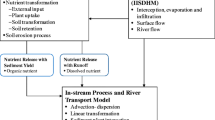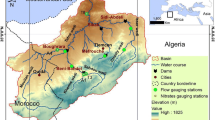Abstract
With the Taihu Basin as a study area, using the spatially distributed and mechanism-based SWAT model, preliminary simulations of nutrient transport in the Taihu Basin during the period of 1995:_2002 has been carried out. The topography, soil, meteorology and land use with industrial point pollution discharge, the loss of agricultural fertilizers, urban sewerage, and livestock drainages were all considered in the boundary conditions of the simulations. The model was calibrated and validated against water quality monitoring data from 2001 to 2002. The results show that the annual total productions of nitrogen (TN) and phosphorus (TP) into Lake Taihu are 40000t and 2000t respectively. Nutrient from the Huxi Region is a major resource for Lake Taihu. The non-point source (surface source) pollution is the main form of catchment sources of nutrients into Lake Taihu, occupied TN 53% and TP 56% respectively. TN and TP nutrients from industrial point pollution discharge are 30% and 16%, and sewerage in both forms of point source and non-point source are TN 31% and TP 47%. Both the loss of agricultural fertilizers and livestock drainages from the catchment should be paid more attention as an important nutrient source. The results also show that SWAT is an effective model for the simulation of temporally and spatially nutrient changes and for the assessment of the trends in a catchment scale.
Similar content being viewed by others
References
David, H., Eutrophication of Freshwaters-Principles, Problems and Restoration, London: Chapman & Hall, 1992.
Wetzel, R. G., Limnology-Lake and River Ecosystems, London: Academic Press, 2001.
Dou, H. S., Jiang, J. H., Five Freshwater Lakes in China (in Chinese), Hefei: China Science & Technology Press, 2003.
Jing, X. C., Liu, H. L., Tu, Q. Y. et al., Lake Eutrophication in China (in Chinese), Beijing: China Environmental Science Press, 1990.
Fan, C. X., Yang, L. Y., Zhang, L., The vertical distributions of nitrogen and phosphorus in the sediment and interstitial water in Taihu Lake and their interrelations, Journal of Lake Science (in Chinese), 2000, 12(4): 359–366.
Fan, C. X., Zhang, L., Yang, L. Y. et al., Simulation of internal loading of nitrogen and phosphorus in a lake, Oceanologia et Limnologia Sinica (in Chinese), 2002, 33(4): 370–378.
Qin, B. Q., Hu, W. P., Gao, G. et al., Dynamics of sediment resuspension and the conceptual schema of nutrient release in the large shallow Lake Taihu, China, Chinese Science Bulletin, 2004, 49(1): 54–64.
Xiao, H. Y., Liu, C. Q., Discrimination between extraneous nitrogen input and interior nitropen release in lakes, Science in China, Ser. D, 2004, 47(9): 813–821.
Xue, L. Q., Lu, X. W., Wu, L., Dynamic simulation study on inner source nutrient exchange between water sediment interfaces in the Xuanwu Lake, Advances in Water Science (in Chinese), 2004, 15(2): 189–192.
Jordan, C., Smith, R. V., Methods to predict the agricultural contribution to catchment nitrate loads: designation of nitrate vulnerable zones in Northern Ireland, Journal of Hydrology, 2004, 295(2): 1–14.
Ding, X.J., Yao, Q., Ruan, X.H., Waste load model for the Taihu Basin, Advances in Water Science (in Chinese), 2003, 14(2): 189–192.
Guo, H. Y., Wang, X. R., Zhu, J. G. et al., Quantity of nitrogen from non-point source pollution in Taihu Lake catchment, Journal of Agro-Environment Science (in Chinese), 2003, 22(2): 150–153.
Li, Y. P., Pang, Y., Lu, J. et al., Quantification relation between the extraneous sources pollution and water quality of Meiliang Bay, Urban environment & Urban ecology (in Chinese), 2004, 17(1): 5–8.
Keith, B., Jim, F., Equifinality, data assimilation, and uncertainty estimation in mechanistic modeling of complex environmental systems using the GLUE methodology, Journal of Hydrology, 2001, 249(1–4): 11–29.
Di, L., Srinivasan, M. R., Arnold, J. G., A GIS-Hydrological Model System for the Watershed Control of Agricultural Nonpoint and Point Sources of Pollution, Transactions in GIS, 2004, 8: 113–136.
Di, L., Srinivasan, M. R., Arnold, J. G., Integration of Watershed Tools and Swat Model into Basins, Journal of the American Water Resources Association, 2002, 38: 1127–1141.
Rosenberg, M., Epstein, D. L., Wang, D. et al. Possible impacts of global warming on the hydrology of the Ogallala aquifer region, Journal of Climate, 1999, 42: 677–692.
Santhi, C., Arnold, J. G., Jimmy, R. et al. Validation of the SWAT Model on a Large River Basin With Point and Nonpoint Sources, Journal of the American Water Resources Association, 2001, 37: 1169–1188.
Qin, B., Q., Hu, W. P., Chen, W. M., Process and Mechanism of Environmental Changes of the Taihu Lake (in Chinese), Beijing: Science Press, 2004, 2.
Wang, S. M., Dou, H. S., China Limnological Chorography (in Chinese), Beijing: Science Press, 1998.
Yang, G. S., Wang, J. D., Xu, P. Z. et al., Taihu Bain-Economic development·Water Environment·Water Disaster (in Chinese), Beijing: Science Press, 2003.
Arnold, J. G., Srinivasan, R., Muttiah, R. S. et al., Large area hydrologic modeling and assessment part I: model development, Journal of American Water Resources Association, 1998, 34: 73–89.
Mackay, D. S., Chen, E., Effects of distribution-based parameter aggregation on a spatially distributed agricultural nonpoint source pollution model, Journal of Hydrology, 2004, 295(1–4): 211–224.
Nicklow, D., Misgana, K., Muleta, G. et al., Sensitivity and uncertainty analysis coupled with automatic calibration for a distributed watershed model, Journal of Hydrology, 2004, 295(6): 2634–2642.
Shi, X. Z., Yu, D. S., Warner, E. D. et al., Soil Database of 1:1,000,000 Digital Soil Survey and Reference System of the Chinese Genetic Soil Classification System, Soil Survey Horizon, 2004, 45(4): 129–136.
Zhu, Q. C., Fan, H. D., The conversion of the standards of soil texture, Chinese Journal of Soil Science (in Chinese), 1999, 30(2): 53–54.
Liang, Y., Shi, X. Z., Soil eradicable K in east hilly fields of the southern Yangtze River, Research of Soil and Water Conservation (in Chinese), 1999, 6(2): 47–52.
Liu, Y., Pereira, L. S., Calculation methods for reference evapotranspiration with limited weather data, Water Project Transaction (in Chinese), 2001, (3): 11–17.
Huang, Y. P., Fan, C. X., Pu, P. M. et al., Water Environment in Taihu Lake and Pollution Control (in Chinese), Beijing: Science Press, 2001.
Pieterse, N. M., Bleuten, W., Jørgensen, S. E., Contribution of point sources and diffuse sources to nitrogen and phosphorus loads in lowland river tributaries, Journal of Hydrology (in Chinese), 2003, 271: 213–225.
Institute of Soil Science, CAS, A Control Countermeasure Research on Agricultural Diffuse Pollution, A Report for National Science and Technology Key-technology Tackling Project in 7th Five-Year Plans (in Chinese), 1990, 9.
Xi, C. F., Xu, Q., Ma, Y. J. et al., Soil and Eco-environment Construction in Changjiang River Basin (in Chinese), Beijing: Science Press, 1994.
William, K., Saunders, B., David, R. et al., A GIS assessment of nonpoint source Pollution in the San Antonio-Nueces Coastal Basin. Center for Research in Water Resources, The University of Texas at Austin, 1996.
Nash, J. E., Sutcliffe, J. V., River flow forecasting through conceptual models part I. A discussion of principles, Journal of Hydrology, 1970, 10(3): 282–290.
Li, R. G., Dai, Q. G., Pi, J. H., Ecological and economic nitrogen application amount of rice and wheat in Tai Lake area of Jiangsu Province, Jiangsu Agricultural Research (in Chinese), 2000, 21(2): 30–35.
Author information
Authors and Affiliations
Corresponding author
Rights and permissions
About this article
Cite this article
Lai, G., Yu, G. & Gui, F. Preliminary study on assessment of nutrient transport in the Taihu Basin based on SWAT modeling. SCI CHINA SER D 49 (Suppl 1), 135–145 (2006). https://doi.org/10.1007/s11430-006-8113-9
Received:
Accepted:
Issue Date:
DOI: https://doi.org/10.1007/s11430-006-8113-9




